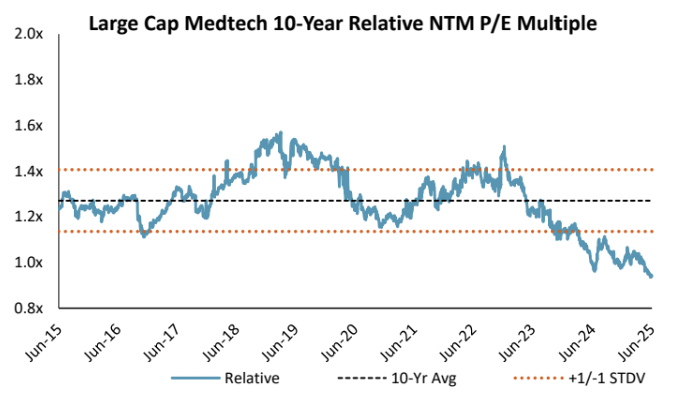Structural growth meets cyclical opportunity: why this sector looks mispriced in 2025
As equity investors, we’re always on the lookout for the trifecta of structural growth, durable competitive advantages, and compelling valuation. But finding all three at the same time is rare.
Right now, I believe that’s exactly what we’re seeing in medical technology, a corner of the market that has quietly de-rated to levels not seen in a decade, as its fundamental tailwinds continue to drive earnings in the face of this multiple compression.
1. Structural Growth: Secular Demand that Defies Cycles
Medical technology is powered by some of the most predictable, long-duration tailwinds in global markets:
Aging populations
Rising chronic disease prevalence
Expanding access to diagnostics, devices, and surgical innovation
For many leading medtech companies, these forces translate into mid-to-high single-digit top-line growth through the cycle and in many cases, faster bottom-line growth due to high gross margins and operating leverage. Whether global GDP is at 2% or 4%, patients still need insulin pumps, pacemakers, neurostimulators, and surgical robots. These are need-to-have technologies, not nice-to-haves.
2. Moats that Matter in a Changing World
In a market obsessed with disruption and disintermediation, medtech stands out for its barriers to entry:
Deep clinical trust built over decades; Edwards Lifesciences (NYSE: EW)
Multi-year regulatory approvals and capital-intensive R&D cycles; Boston Scientific (NYSE: BSX)
Network effects within health systems; Abbott (NYSE: ABT)
Sticky install bases and razor/razorblade models; Intuitive Surgical (NASDAQ: ISRG)
Even in an AI-infused investment world, these moats remain intact. In fact, many of the sector’s leaders are actively leveraging AI to expand their advantage, such as DexCom’s (NASDAQ: DXCM) real-time glucose monitoring platforms or Edwards’ AI-enhanced diagnostic capabilities.
Unlike many industries where AI threatens to compress margins or displace incumbents, in medtech it is an enabler, not a disruptor.
3. Valuation: The Mispricing Few Are Watching
Here’s where it gets interesting.
After years of outperforming, the medtech sector has de-rated sharply over the past 3-years. The chart below shows the sector’s 10-year NTM P/E multiple relative to the S&P500, which is now approaching 1.0x versus the broader market, which is close to -2 standard deviations from its 10-year average.

Throughout this de-rate period, earnings growth has persisted, driving many companies market caps higher even in the face of compressed multiples. Balance sheets remain strong and large-cap companies are alert to M&A opportunity. Yet investor positioning remains light, as the market continues to crowd into megacap tech and AI beneficiaries.
In our view, this disconnect creates opportunity. You're paying market multiples for a sector with above-market growth, better returns on capital, and stronger downside protection.
The Setup: Structural Growth + Moats + Valuation
This is the rare moment where the math and the narrative align.
At Cordis, we invest exclusively in public medical technology companies. We look for durable growth, pricing power, and long-term relevance. We believe the current environment offers exactly that, at prices that don’t reflect the quality on offer.
If you're a long-term investor looking for exposure to one of the most innovative, globally relevant sectors, now might be the time to take a closer look.
Visit our website to learn more about the Cordis Global Medical Technology Fund and our investment strategy.
4 topics
5 stocks mentioned

